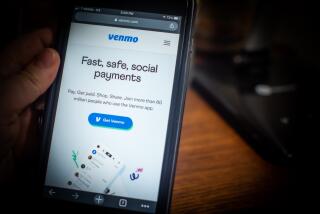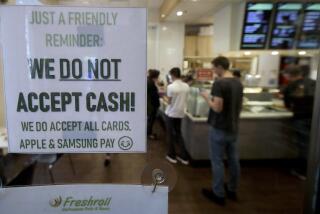Businesses remain on Apple Pay sidelines
For years, the big question facing mobile payment systems was whether enough shoppers would use them.
Turns out, they will. IPhone 6 users rushed to register more than 1 million credit cards on Apple Pay in the first 72 hours last week, making it the most widely used contactless payment system available. Whether buying a burger at McDonald’s or fueling up at a Chevron station, consumers have lauded the ability to pay with their phones and a fingerprint.
The more pressing challenge, at least in the near term, is getting reluctant businesses on board.
From major chain stores to small mom-and-pop shops, many businesses are choosing to wait on the sidelines. Fewer than 10% of retailers are equipped to handle such payments, according to research firm Gartner. That’s a problem for Apple and other mobile wallet operators that need a critical mass of merchants to help get their systems off the ground.
“From a consumer standpoint, it’s working great so far,” said Mark Hung, Gartner research vice president. “But right now Apple is not really offering a carrot to merchants to adopt it. Today it’s of no benefit to the merchants to offer this.”
For business owners, there’s the cost of buying and installing the payment terminals and the time it takes to train employees on how to use them. Some don’t think it’s worth the trouble — how hard is it, really, for customers to take out their wallets and whip out a credit card or cash?
“Pulling out your credit card and swiping it is not all that big of a problem. It’s not a bad user experience,” said Michael Brown, general partner at venture capital firm Battery Ventures. “It’s trusted and it’s fine, so you need to have a much more compelling use case.”
Locally, many small businesses said they haven’t even begun to consider whether to accept the new payment methods.
“We currently don’t accept mobile payments and at this point I’m not very educated on it,” said Josh Loeb, co-owner of restaurants that include Santa Monica’s Rustic Canyon and Milo & Olive. “As of now it’s a big gray area for me.”
Another problem: Apple’s entrance into the burgeoning space has set off a battle between it and a competing system being developed by a coalition of big retailers.
Shortly after Apple Pay launched on Oct. 20, CVS and Rite-Aid disabled near-field communications technology, effectively icing Apple Pay — along with other mobile wallets — out of their stores.
“We are in the process of evaluating mobile payment options for our customers,” CVS spokesman Mike DeAngelis said.
The pharmacies belong to Merchant Customer Exchange, or MCX, a group of big retailers including Walmart, Target, Best Buy and Gap that is developing its own mobile wallet called CurrentC. A big benefit of CurrentC, at least from the retailers’ perspective: It can track shoppers’ locations and spending, giving merchants valuable information on how their customers shop. Participating merchants will also get to avoid paying credit card fees.
MCX has sought to contain some of the fallout it faced after Rite-Aid and CVS pulled their support of Apple Pay, saying in a blog post that it wanted to “set the record straight” on some misconceptions about its CurrentC product. In particular, it stressed it did not order MCX retailers to shut off their terminals.
At a tech conference in Laguna Beach this week, Apple Chief Executive Tim Cook called the MCX stand-off a “skirmish” and said he believed Apple Pay was the “first and only” mobile payment system out there that was easy to use, private and secure.
On Tuesday, MCX — which had already faced criticism from analysts who said it looked too cumbersome for widespread consumer adoption — said its system had been hacked by “unauthorized third parties” who obtained email addresses of some CurrentC pilot program participants and other individuals who had expressed interest in the app.
Cook conceded that Apple Pay still has “a lot more merchants to sign on,” but said the early stages look promising. He also issued a warning to retailers who are choosing to sit out.
“Merchants have different objectives sometimes, but in the long arc of time you only are relevant as a retailer or a merchant if your customers love you,” Cook said.
Getting enough businesses on board is imperative if Apple wants to permanently change consumers’ payment habits. The buzz surrounding Apple Pay’s launch is propelling much of its activity now, but once that initial hype wears off, it needs widespread merchant support.
Apple Pay is currently accepted by roughly 220,000 stores nationwide, including Subway, Bloomingdale’s, Macy’s, Petco and Whole Foods.
Apple Pay uses a technology called near-field communication, or NFC, to wirelessly send payments. Users simply hold their iPhones near the payment terminal while holding one finger on the TouchID home button on their phones. A quick vibration and beep alerts the user that a payment has been made.
Mobile payments have been around for years, with options such as Google Wallet offering consumers a more convenient way to pay for goods without digging into their wallets. But none of them has taken off in a big way.
Apple’s entry into the space could change that. The company has clout among consumers, prompting Visa, MasterCard and American Express to quickly sign on to the system, along with hundreds of banks.
Despite some merchant unwillingness, mobile payments are expected to explode over the next few years. The market is estimated to skyrocket to $90 billion in the U.S. in 2017, up from a mere $12.8 billion in 2012, according to Forrester Research.
MasterCard has been reaching out to merchants to get them educated on Apple Pay and encourage them to accept it in their stores.
It is also working with Rite-Aid and CVS to get them back on the system, said James Anderson, MasterCard’s senior vice president of emerging payments.
“We think it’s really hard to be successful if you choose not to offer stuff your customers want,” he said.
Twitter: @byandreachang
Twitter: @ByShanLi
More to Read
Inside the business of entertainment
The Wide Shot brings you news, analysis and insights on everything from streaming wars to production — and what it all means for the future.
You may occasionally receive promotional content from the Los Angeles Times.











